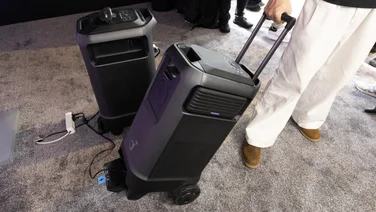To help us provide you with free impartial advice, we may earn a commission if you buy through links on our site. Learn more






































- Super light and compact
- Excellent video and decent photo quality
- Flys superbly
- Battery life not the best
Let’s not beat about the bush: the DJI Mavic Air is my favourite drone ever. It’s not cheap, but it’s a lot more affordable than DJI’s high-end models (the Phantom 4 Pro comes in at a stiff £1,589). And it ticks every box worth ticking.
That starts with its ultraportable design. Much like DJI’s superb Mavic Pro, the Air can be folded away for wonderfully easy transport and storage. With its rotor arms fully folded in, it’s smaller even than DJI’s dinky Spark, measuring just 168 x 184 x 64mm, and at 430g it’s jolly light, too.
Yet that small size doesn’t mean that corners have been cut. Although it’s smaller and cheaper than the older Mavic Pro, it has a more advanced feature set and better video quality.
DJI Mavic Air review: Price and competition
That quality and advanced feature set is reflected in the price. At £769, the DJI Mavic Air is a serious purchase and intended for enthusiast and semi-professional use. At that price, most of its competition comes from the DJI stable of drones. The DJI Mavic Pro, which isn’t quite as accomplished or as compact, but has longer battery life, can be had for a similar price these days, while the diddy DJI Spark, which is restricted to 1080p video but is also brilliant is around £350.
Perhaps the stiffest competition for the Mavic Air, however, will come from the new Parrot Anafi, which is set to offer 4K video recording in a similarly compact package and will cost around £630.
DJI Mavic Air review: Image quality
On paper, you might expect the Mavic Air to produce identical footage to its the Mavic Pro, since it uses the same 1/2.3in sensor, coupled with an f/2.8 lens that has an 85° field of vision. The maximum frame rate hasn’t changed either: you’re limited to 30fps at 4K, although there’s now a slow-motion 120fps mode available in 1080p.
What’s different is that the Air’s camera is mounted on a full three-axis gimbal, rather than the two-axis unit of the Spark. This ensures your shots look wonderfully smooth and fluid, even in choppy wind conditions.






































Moreover, the Air encodes its footage at a much higher bitrate. Where the Mavic Pro was limited to 60Mbits/sec, the new model raises the bar to a remarkable 100Mbits/sec. This means much more fine detail is retained; the big picture might not look vastly different, but low-contrast scenes (such as fields of grass, or rippling oceans) come out with much better definition.
There’s good news for stills photographers too, with a great range of shooting modes on offer. I’m a particular fan of the new Sphere Panorama mode, in which the drone rotates in place to generate a 32-megapixel, 360° view, which you can zoom in and pan around in the DJI Go app. Other options include HDR, multi-exposure bracketing, and vertical and horizontal panorama shots.
It must be said that still image quality is good, rather than exceptional: in particular, dark areas can get quite murky and grainy. However, you can optionally capture in in RAW format and, if you take advantage of the Mavic Air’s bracketing features, you can use third-party editing software to combine multiple exposures and create some nice composites.






































DJI Mavic Air review: In flight
A great camera is one thing, but if your drone is a chore to fly then it’s not going to bring you much joy. I’m delighted to say that that isn’t the case with the Mavic Air at all: it’s superbly nippy and responsive – not to mention pleasingly quiet – and you can choose from three different ways to control it, according to your preference.
The first is to fly it with your smartphone. Frankly, I don’t think this is a great experience: the touchscreen controls feel a bit ham-fisted and imprecise, which is very much at odds with the nimbleness of the drone itself. But it’s nice to have the option.
The second way is via DJI’s “Smart Capture” mode. This might feel like a bit of a gimmick but it’s quite fun and impressive to watch. With this control mode activated, the drone watches you through its camera, and responds to the way you wave your hands and arms: for example, you can make a “V” sign with your fingers to have the drone take a selfie, form a rectangle with your fingers to start recording video, or simply wave your hand purposefully to make the Mavic Air fly around. You can’t get the drone to take off or land on your palm, as you can with the Spark, but, still, it’s pretty cool.






































Which brings us to the third method of flying the Mavic Air: via the supplied remote control. This might sound boringly conventional but it gives you the most precise control and much better range. DJI says you can control the Mavic Air from up to 4km away this way, although remember that UK law requires you to keep it within sight at all times. It also lets you switch the drone into high-performance “Sport” mode, with a breakneck maximum speed of 42.5mph – though I suggest less experienced flyers leave it in standard mode, as it’s alarmingly easy to destroy a drone by crashing it at high velocity.
There’s no built-in screen on the controller as there was on the Mavic Pro’s remote but there’s no need as the remote is designed specifically so your phone clips to the bottom of the controller between the hand grips. Here, it shows a live camera view and gives access to tall the drone’s various settings and camera controls. In one particularly neat trick, the controller’s twin joysticks can be unscrewed and stowed in small rubber clips beneath the hand grips, again helping to keep the Mavic Air easily portable.






































Whichever control method you choose, though, the drone is remarkably solid in the air and flies with an impressive sense of purpose, even in moderate wind. It’s equipped with object avoidance sensors at both the front and the rear, which helps you avoid expensive collisions (the Pro was only able to detect objects in front of it). With nerves of steel, I tested this in my usual way, by flying the drone directly towards myself: sure enough, no matter which way it was facing, the drone steadfastly refused to collide with me.
DJI Mavic Air review: Drawbacks and limitations
The Mavic Air does have its foibles. I went through some frustrating head-scratching trying to work out how to switch between smartphone and remote-control mode. I also found that the gimbal cover (which protects the fragile three-axis stabiliser in transit) is a bit fiddly to put back in place once you’ve finished flying. And be aware that that point comes around quite soon: the Mavic Air has a rated flying time of 21 minutes, which is a fair bit shorter than the Mavic Pro’s 27 minutes. Finally, if you try to clip an iPhone X into the remote control, you’ll find that the grips cover up the Face ID camera, which makes unlocking the thing a little bit more of a pain than it needs to be.
Mavic Air review: Verdict
Despite a few minor gripes, though, the DJI Mavic Air is a superb product. It’s a fully featured quadcopter that will fold up and fit into a small bag, or even a large pocket. You can control it in the traditional way, use your phone to conveniently tap and fly, or direct it about just by waving your hands. It flies beautifully, and it shoots simply superb video.
Again, it’s not exactly cheap. But it’s a drone that’s well up to the task of capturing never-to-be-forgotten photos and videos that you simply couldn’t obtain any other way, and it’s a hell of a lot of fun to fly. Considering how much you can pay these days for a standalone, ground-based action camera, I’d say the DJI Mavic Air is an irresistible bargain.








